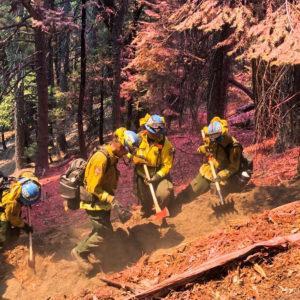At The Corps Network’s annual National Conference, we celebrate the important services Corps provide to communities and young people across the country by honoring Corps that have undertaken especially noteworthy endeavors within the past year. Projects of the Year are innovative and show a Corps’ ability to work with partner organizations, give Corpsmembers a positive experience, and provide the community with meaningful improvements.
 This project included AmeriCorps members.
This project included AmeriCorps members.
In 2020, Corpsmembers with the California Conservation Corps (CCC) certainly experienced the program’s motto: “Hard Work, Low Pay, Miserable Conditions, and More!” Though emergency response projects have long been part of the CCC’s mission, the need in 2020 was unprecedented. The organization saw the largest emergency deployment in their 44-year history, with more than 2,000 Corpsmembers engaged in some form of emergency response work.
While the world faced a pandemic, California also experienced the worst wildfire season on record: over 4 million acres burned across the state, devastating communities and habitats. The young adults of the CCC were an integral part of the state’s response effort, serving over 1.1 million hours on 296 fire incidents.
Corpsmembers engaged in a range of critical activities. Some served on the frontlines, removing vegetation from the path of advancing wildfires and creating a pathway for additional fire suppression resources. These specially trained “fire crew” Corpsmembers also come in after a fire is contained to extinguish hotspots.
Through intense heat, and in steep terrain, these Corpsmembers cut fire breaks and cleared debris, helped fight fire with fire and were rewarded with knowing they made a difference and helped a community.
Some Corpsmembers supported fire camp operations. This included helping organize, inventory, and maintain gear. Corpsmembers are responsible for helping untangle, clean, and roll thousands of miles of fire hose. They also help pressure test hoses to ensure they are safe to use again.
Fire camp crews also support the food service by making and distributing sack lunches, refilling drink troughs, and unloading heavy cases of ice. Additionally, Corpsmembers assisted with camp communication by answering phones and delivering messages. Many also engaged in facilities upkeep, helping control traffic, clean the restrooms and showers, and set up tents, fences, and information kiosks.
Filling sandbags, building muscle wall, and laying hundreds of feet of wattle all in the name of protecting Lake Berryessa—the source of water where Corpsmembers live, work, and play. It means something to make a difference in the wake of this summer’s wildfire disasters.
In addition to serving directly on wildfires, CCC crews implemented erosion control treatments to mitigate damage. Crews placed wattles in areas where homes burned to prevent toxic household chemicals from reaching community water sources. Wattles also help prevent soil erosion and reduce flooding by decreasing the amount of debris that can wash into waterways.
In addition to responding to these natural disasters, CCC members were on the frontlines of the COVID-19 crisis. Corpsmembers have spent over 94,000 hours and counting engaged in activities including staffing food banks, distributing emergency medical supplies, and setting up temporary alternative care facilities.
Corpsmembers on wildfire response projects serve around the clock. During emergency response deployments, crews worked a minimum of 12-hour shifts for 14 days straight. The norm was for Corpsmembers to serve 21 days straight with 12-16-hour shifts. Fire crews served 24-hour shifts and, in some cases, worked over 45 days straight. Corpsmembers responded to emergencies in 115-degree heat and in the snow. They lived in tents, ate whenever they could, and slept minimally.
CCC Inland Empire Corpsmembers are assisting our partners at the U.S. Forest Service by putting used hose to the test through 300psi pressure testing. The crew is testing hoses and checking all returned equipment from fire base camps to see if it’s in good enough shape to be re-used on the next incident.
After a trying year, Corpsmembers who served in emergency response are well prepared for jobs in firefighting, logistical support, the forestry industry, and other emergency response organizations. Whereas a typical Corpsmember usually graduates with chainsaw experience, firefighting members have now graduated with an S-212 or a Faller certification. They also receive a higher level of medical training, such as wilderness first aid or even EMT certification. Beyond certifications, however, Corpsmembers from 2020 developed grit and the know-how to work hard and maintain professionalism, even in the toughest of circumstances.
The flexible nature of the CCC’s emergency response program proved to be extremely beneficial this past year. This program has allowed them to explore partnerships with new agencies in need of emergency response support, in turn giving the CCC a larger footprint of service. Unfortunately, as predictions indicate that wildfires and other natural disasters will not decrease in scale or frequency any time soon, the CCC and other Corps will likely be an increasingly important asset in disaster response and mitigation.




































































